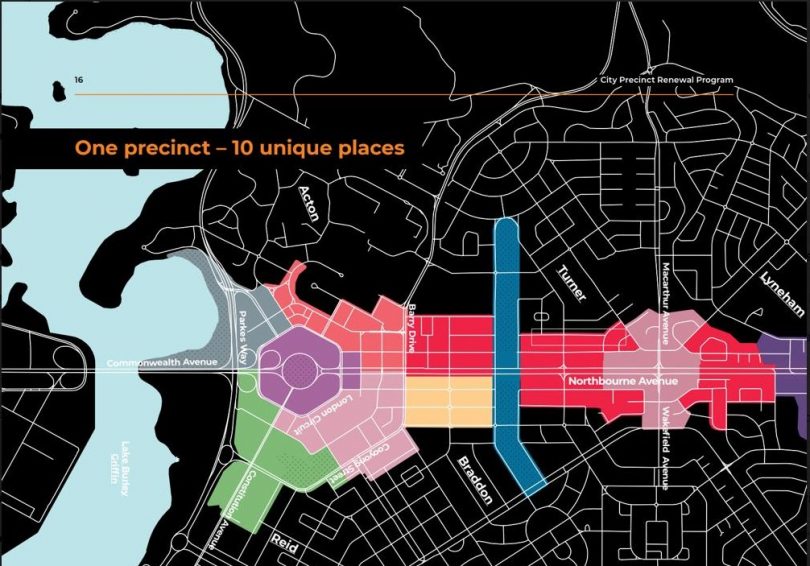
The City Precinct plans announced this year mean that multiple complex developments will be seeking approval concurrently. Image: Supplied.
The ACT Government’s focus on infill development as a means of increasing housing supply, supporting utilisation of infrastructure and generally bolstering the economic health of the Territory is good policy.
However, this very focus is conspiring to hamper the outcomes government desires — much in the same way that a tourism spot popular for its uncrowded spaces kills itself by attracting tourists in high numbers.
Add the impacts of the Mr Fluffy program and there’s enormous pressure being placed on the planning staffing resources that are needed to ensure the smooth transit of major and complex development applications (DAs) through the approval process.
It’s well recognised that lengthy DA approval times contribute not only to economic inefficiencies and productivity lags, but also to a reduction in housing affordability.
In the ACT, where land release and management is subject to only one tier of government (except in a few cases where the National Capital Authority is involved), refining and streamlining this process should be easier.
It should be an exemplar. However, this is not the case.
Other jurisdictions (and particularly a small number of local councils) are leading the field, recognising that reduced approval times lead to greater economic efficiencies and overall growth. Given the ACT Government’s current focus on urban infill and densification to ensure full use of existing and new infrastructure (such as light rail), a streamlined DA process is critical.
It will be difficult, if not impossible, for such development to take place with approval timeframes of 10 months or more. And given the likelihood of an increasing number of complex DAs being lodged concurrently, as well as several other major projects already in the system, this timeframe could well push out beyond 12 months. This timeframe creates significant issues for any development project considering the impact of delays on holding costs, workforce management, sales rates and settlements.
While the ACT Government can be applauded for streamlining the pre-DA process, lengthy approval times are having the most significant negative impact on developers and home buyers from both a cost and an efficiency point of view.
Ultimately, longer and more expensive development processes impact local citizens and home buyers. Higher development costs are passed on to home buyers. Longer development timeframes impact local economic activity, investment and productivity.
So what is the answer?
One reform of note is the use of expert panels for assessing DAs, an idea given particular consideration by Yolande Stone in her work Council Decision Making and Independent Panels.
Stone focuses panel decision making as a way to depoliticise the process and to address probity concerns. For example, councillors, property developers and real estate agents are generally prevented from becoming a member of the new panels, ensuring independence from decision-makers.
For major or controversial DAs, independent panels provide a peer review of the technical assessment along with increased opportunities for applicants and objectors to input into the assessment process, increasing transparency and strengthening the integrity of decision-making.
Many councils and planning bodies have adopted panels as part of their DA approval process for the sole purpose of both actually reducing corruption as well as the perception of it. Polling by Newgate Research, commissioned by the Property Council, found high levels of community support for planning panels to depoliticise the development assessment process, with 81 per cent of respondents agreeing that large planning decisions should be made by experts.
Given the ACT Government’s recent decision to broaden the remit of its Design Review Panel (DRP), perhaps it is time to establish assessment panels in the ACT to consider Development Applications in their entirety – not only to speed up applications but also to provide transparency to the decision-making process.
Relevant expertise would be in the fields of planning, architecture (eliminating the need for a separate DRP), heritage, the environment, urban design, economics, traffic and transport, law, engineering, tourism or government and public administration. A community representative panel member should also be included. The members, including a Chair, would be chosen by the Chief Planning Executive.
The panel would be remunerated from fees paid by developers on a user pays or opt-in basis, however, any project above a certain size could automatically be referred to the panel, freeing up resources within EPSD and accelerating their broader assessment activities. EPSD staff would also benefit from exposure to, and mentoring from, the members of the assessment panels as there would still need to be administrative support from the directorate.
A key issue in this process is conflicts of interest and it is one that must be managed carefully, however, at the end of the day the panel is providing advice to the Chief Planning Executive, not making a decision. The final approval (or otherwise) would almost certainly continue to rest with the ACT Planning Authority.
Dan Stewart has a long history in Canberra urban planning. He spent 14 years in ACT government executive positions before moving to the private sector.





















